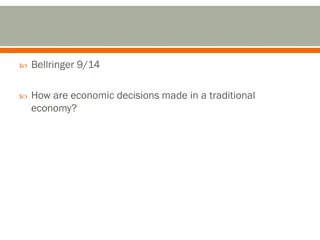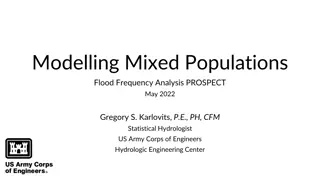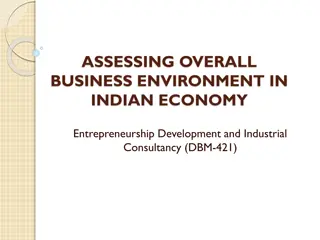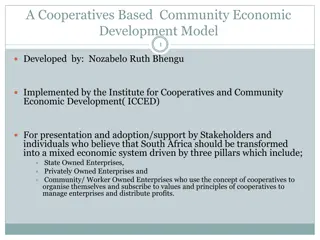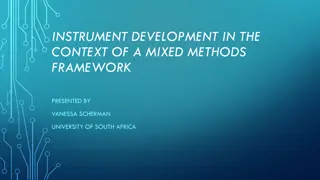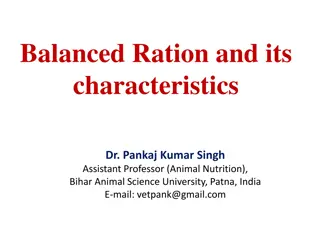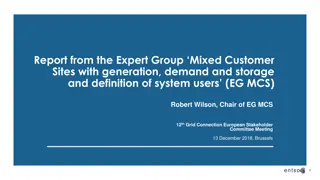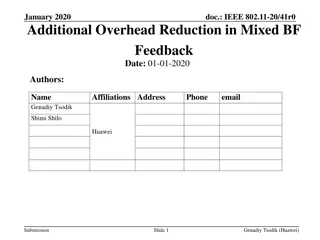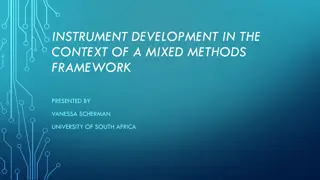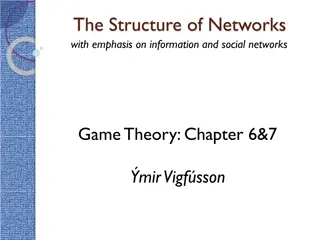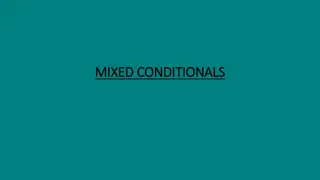Understanding Mixed Economy: A Balanced Economic Model
Mixed economy combines elements of socialism and capitalism, allowing both public and private sectors to coexist. Government intervention aims to achieve a balance between individual initiatives and societal goals, promoting economic development while addressing inequalities. Features include economic planning, personal freedom, controlled price mechanisms, and a focus on economic welfare. The concept has evolved through historical compromises and influences from various economic ideologies.
Download Presentation

Please find below an Image/Link to download the presentation.
The content on the website is provided AS IS for your information and personal use only. It may not be sold, licensed, or shared on other websites without obtaining consent from the author. Download presentation by click this link. If you encounter any issues during the download, it is possible that the publisher has removed the file from their server.
E N D
Presentation Transcript
MIXED ECONOMY MIXED ECONOMY www.presentationgo.com
GOLDEN MIX OF GOLDEN MIX OF LOREM IPSUM Socialism Capitalism Free enterprise Economic liberty Non-interference of the state Invisible hand Forces of demand and supply Socailisation of means of production No private enterprise- based on self interest, private property State control www.presentationgo.com
Mixed Economy Mixed Economy- - Meaning Meaning Mixed economy implies demarcation and harmonisation of the public and private sectors. LOREM IPSUM market mechanism is not permitted and the government intervenes or regulates the private sector in such a way that the two sectors become mutually re-inforcing. A mixed economy represents an achievable balance between individual initiative and social goals. There is a commitment on the part of both the sectors to national objectives and priorities. www.presentationgo.com
Features Features Pre designed strategy For the promotion of economic development. 05 Economic Planning 04 Private Property is allowed Govt is there to check concentration of wealth Full freedom of occupation. But controlled by the state 03 Personal Freedom Avoid regional inequalities, provide empt. opportunities, control private activities through fiscal and monetary policies 02 Economic Welfare Basic and Key industries- long gestation period, Risk, huge invst. Consumer goods industries, agriculture, small scale industries- Co-existence of Public Sector & Private Sector 01 www.presentationgo.com
Features Features Price Mechanism and Controlled Price price mechanism and regulated price operate simultaneously 06 Encouragement is given to free economic activities and at the same time steps are also taken to control economic activities Free and Controlled Economic Development 07 profit motive like capitalism and social welfare as in socialist economy. 08 Profit Motive and Social Welfare reduce the gap between rich and poor through progressive taxation. The subsidies and job opportunities are provided to poor people 09 Check on Economic Inequalities huge initiatives to control monopoly practices among the private entrepreneurs through effective legislative measures 10 Control of Monopoly Power www.presentationgo.com
EVOLUTION OF THE CONCEPT EVOLUTION OF THE CONCEPT Compromise- intervention enterprise state free and Great depression and J.M Keynes Karl communist Regimes in USSR, China, Vietnam, Cuba etc. Max and Rise of Classicals in the 18th and 19thCentury www.presentationgo.com
EVOLUTION OF MIXED ECONOMY IN INDIA EVOLUTION OF MIXED ECONOMY IN INDIA Industrial Policy Resolution of 1980 Industrial Policy Resolution of 1977 Industrial Policy Resolution of 1956 Beginning Economic Planning www.presentationgo.com
EVOLUTION OF MIXED ECONOMY IN INDIA EVOLUTION OF MIXED ECONOMY IN INDIA Industrial Policy Resolution- on 30th April, 1956 Schedule A : Those industries which were to be the sole responsibility of the State. This list included 17 industries - arms and ammunition, atomic energy, iron and steel, heavy machinery required for mining, heavy electrical industries, coal, mineral oils, mining, iron ore and other important minerals, aircraft, air transport, railways, ship-building, telephone, telegraph and wireless equipment, and generation and distribution of electricity. www.presentationgo.com
EVOLUTION OF MIXED ECONOMY IN INDIA EVOLUTION OF MIXED ECONOMY IN INDIA Schedule B : There were about a dozen industries in the list, where the State might establish new units or existing units might be progressively nationalised. In these industries, the private sector was guaranteed plenty of opportunity to develop and expand. Other mining industries, aluminium and other non-ferrous metals not included in Schedule A, machine tools, ferro alloys and steel tools, chemicals, antibiotics and other essential drugs, synthetic rubber, pulp, road and sea transport. www.presentationgo.com
EVOLUTION OF MIXED ECONOMY IN INDIA EVOLUTION OF MIXED ECONOMY IN INDIA Schedule C : Industries in this Schedule consisting of the rest of the industries, not included in Schedules A and B, would be in the private sector and would be subject to the social and economic policy of the government. www.presentationgo.com
EVOLUTION OF MIXED ECONOMY IN INDIA EVOLUTION OF MIXED ECONOMY IN INDIA Industrial Policy of 1977 was very critical of the 1956 Resolution on the ground that "Unemployment has increased, rural-urban disparities have widened and the rate of real investment has stagnated. The incidence of industrial sickness has become widespread and some of the major industries are worst affected. The new policy focused on the development of small scale sector, cottage and household industries and the tiny sector. It further provided for using provisions of the Monopolies and Restrictive Trade Practices Act against expansion of larger industrial houses. www.presentationgo.com
EVOLUTION OF MIXED ECONOMY IN INDIA EVOLUTION OF MIXED ECONOMY IN INDIA The public sector was to be used for providing strategic goods of basic nature and also for maintaining supplies of essential goods. In areas where foreign collaboration was not required because of the availability of indigenous technical know-how, such collaboration agreements were not be renewed www.presentationgo.com
EVOLUTION OF MIXED ECONOMY IN INDIA EVOLUTION OF MIXED ECONOMY IN INDIA Industrial Policy 1980 Policy accorded priority to optimum utilisation of installed capacity, balanced regional development, agro-based industries, export-oriented industries and promoting "economic federalism" by equitable spreading of investment over small but growing industrial units in urban as well as rural areas. www.presentationgo.com
India as a Mixed Economy India as a Mixed Economy Under the Directive Principles of the Indian Constitution, it has been laid down that the State should strive "to promote the welfare of the people by securing and protecting as effectively as it may a social order in which justice, social, economic and political, shall inform all the institutions of national life. www.presentationgo.com
India as a Mixed Economy India as a Mixed Economy Positive Economic Role of the State 01 Mixed Economy Co-existence of Public and Private Sectors 02 Mixed Economy Combined features of Capitalism and Socialism 03 Mixed Economy www.presentationgo.com







